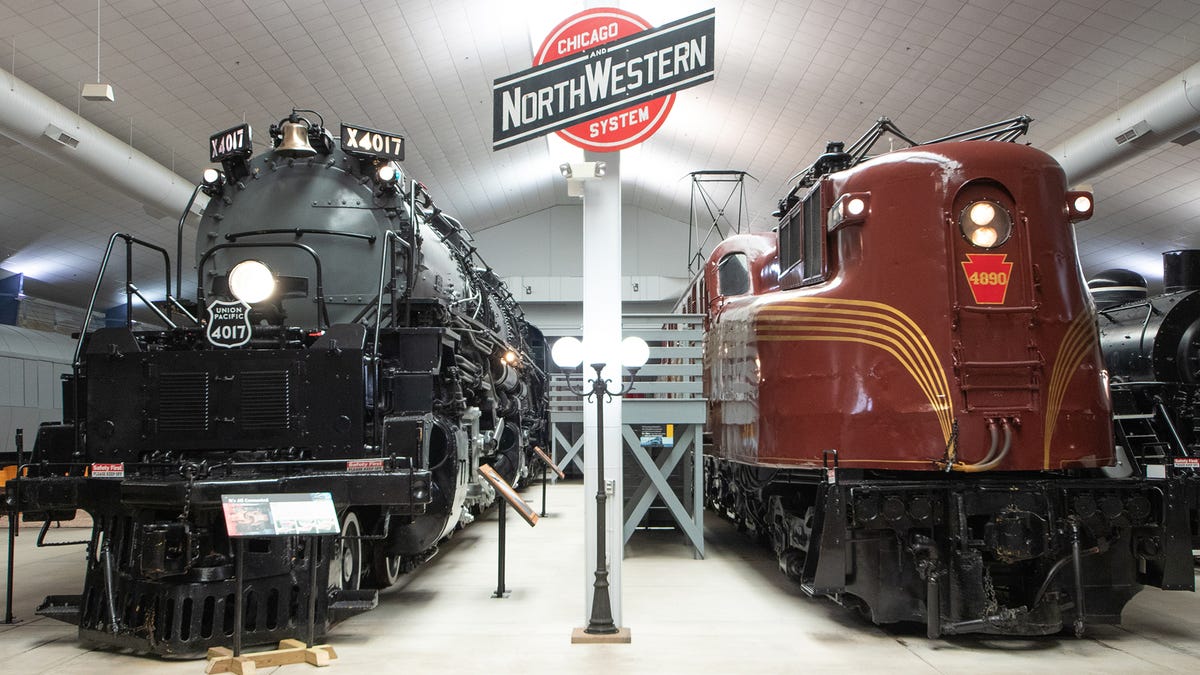 Why You Can Trust CNET
Why You Can Trust CNET An Aerotrain and historic high-speed behemoths at the National Railroad Museum
Just outside of Green Bay, Wisconsin is a fascinating museum showcasing over 100 years of railroad history. Here's a look around.

Green Bay, Wisconsin, is probably best known as a town that could fit nearly its entire adult population into its professional football stadium (all wearing cheeseheads, of course). Within sight of Lambeau Field, however, is museum that holds a different kind of history -- the kind that helped build the West and the entire country.
Under the sprawling train sheds of the National Railroad Museum you'll find over 100 years of railway history, from steam engines to high-speed diesel-electrics and from classic dining cars to historic sleepers. There's a lot to see here.
One of the most notable is GM's Aerotrain, a streamlined and futuristic midcentury creation that once looked like the future, but has since faded into the past. Here's a look around.
Aerotrain
In 1955 General Motors wanted to shake up the passenger train industry. Sure, the car side of its business was doing great, but like any huge conglomerate wanting to maximize profit. So it came up with a flashy plan that leveraged multiple arms of the company to bring together something new and shiny.
And new and shiny it was. The Aerotrain looked like no other train of the era. Its streamlined locomotive looked more like GM's jet-inspired cars of the era. It looked fast, and was designed to cruise at over 100mph, reducing the time between major cities in some cases by hours. Remember, this was before the high-speed interstate highway system. And in the air, the prototype that would lead to Boeing's 707 had only just flown the year before. That made the idea of a 100mph long-distance train a huge promise.
In order to minimize design time and maximize profits, GM rummaged through its corporate parts bin. Power was from a V12 engine sourced from their Electro Motive Division, the cars were modified bus shells from GMC and aluminum was used throughout to save weight. The overall look was overseen by legendary automotive designer Chuck Jordan who became not only the chief designer of Cadillac in the late 1950s (think "fins") but later vice president of design for all of General Motors.
The result was... bad, actually. Like, really bad. While the train looked fantastic, garnering interest among the public and railroad companies alike, its performance was abysmal. The engine was woefully underpowered, and despite its lighter weight, the Aerotrain had trouble going up hills without assistance. The cars were unpleasantly loud and they bounced around so much on their air suspension that they were basically unusable over 60 miles per hour.
All but one railroad passed on purchasing Aerotrains. The one that did -- the Chicago, Rock Island and Pacific Railroad -- bought the three prototypes at a huge discount and ran them on low-speed, short-distance commuter services in the Chicago suburbs. Even in this diminished role they didn't last long, getting retired after eight years. One was sold for scrap, one went to the National Museum of Transportation in St. Louis and one is here.
Being covered, but not completely indoors, the Aerotrain could use some TLC. Dust and bird droppings cover much of the exterior, and the interiors of the locomotive and two cars are off limits (though not to a GoPro on a selfie stick) and unrestored. With any museum, especially train museums, maintenance and cleaning is an expensive and ongoing process. And given the state of the world the over past year, it's hard to fault the museum for focusing efforts on the more important vehicles in its care.
Making steam
While my fascination with the Aerotrain prompted my visit, the National Railroad Museum has many other historic and impressive locomotives and railcars. The Dwight D. Eisenhower is a British Class A4 high-speed behemoth, one of only four still in existence, that held records for decades on the the UK's East Coast Main Line. The gigantic Union Pacific "Big Boy" is one of the largest locomotives ever built, and is in immaculate condition.
In all, there's more than a century of rail history, including cabooses, Pullman sleepers and a plow car that's like a rolling wood cabin.
If you're not headed to Green Bay, check out the gallery above for a look back at some fascinating rail history.
As well as covering audio and display tech, Geoff does photo tours of cool museums and locations around the world, including nuclear submarines, aircraft carriers, medieval castles, epic 10,000-mile road trips and more.
Also check out Budget Travel for Dummies, his travel book, and his bestselling sci-fi novel about city-size submarines. You can follow him on Instagram and YouTube.

